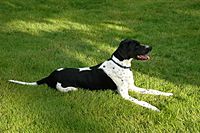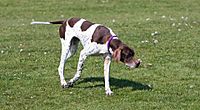Pointer (dog breed) facts for kids

Orange and white Pointer
|
|||||||||||||||||||||||||||||
| Other names | English Pointer | ||||||||||||||||||||||||||||
|---|---|---|---|---|---|---|---|---|---|---|---|---|---|---|---|---|---|---|---|---|---|---|---|---|---|---|---|---|---|
| Origin | England | ||||||||||||||||||||||||||||
|
|||||||||||||||||||||||||||||
|
|||||||||||||||||||||||||||||
| Domestic dog (Canis lupus familiaris) | |||||||||||||||||||||||||||||
The Pointer, sometimes called the English Pointer, is a medium-sized dog breed from England. These dogs are known for helping hunters find game. Many people who love hunting dogs think Pointers are one of the best breeds for this job. However, unlike most other "pointing" breeds, their main purpose is to show where the game is, not to bring it back.
Many believe the Pointer came from the Old Spanish Pointer. These dogs were brought to England by soldiers returning from Spain in the early 1700s. Once in England, they were bred with local dogs to make them even better at hunting.
Contents
What's in a Name?
The Pointer gets its name from how it acts when it smells game. It stands very still, "pointing" its nose towards the hidden animal. This helps the hunter know exactly where the game is. The breed is sometimes called the English Pointer to tell it apart from other pointing dog breeds. In the United States, especially in the South, the term "bird dog" often refers specifically to the Pointer breed.
Pointer History
Dog experts have talked a lot about where the Pointer breed came from. The most common idea is that Pointers came from Old Spanish Pointers. These dogs were brought to England around 1713. This happened when soldiers came back from Spain after a peace treaty.
Some early writings suggest that Pointers might also have come from Portuguese Pointers, Italian Braccos, or French pointers. In 1902, a sportsman named William Arkwright wrote an important book about the Pointer's history. He looked through many old records but didn't find strong proof that Spanish Pointers were the only starting point. Still, he thought it was the most likely story.
It's important to remember that in those days, dog breeds weren't as clearly defined as they are today. There were many types of "pointing dogs" across Europe. These were usually short-haired, hound-like dogs that used their noses to find birds.
Another idea is that a type of Pointer was in England much earlier. These dogs might have been used in medieval times to find hares for hunting with greyhounds or hawks. Later, these English dogs were likely mixed with imported European pointers.
The first records of Pointers in England are from the early 1700s. A writer named John Gay mentioned Pointers hunting partridge in a poem from 1713. Also, a painting from 1725 shows a kennel of Pointers.
Over time, early Pointers in England were bred with other dogs. This was done to add useful traits. They were crossed with setters, bloodhounds, and foxhounds. Some people even mention Bull Terriers and bulldogs.
At first, Pointers were heavy dogs. They could hold a steady point while the hunter got ready to shoot. As guns got better in the 1700s and 1800s, people wanted faster dogs. So, greyhounds were added to the mix to make Pointers quicker. This is why modern Pointers look more like Greyhounds. They are leaner with a tucked-up belly and a low-set tail.
The official rules for the Pointer breed were set in 1936. They haven't changed much since then.
What Pointers Look Like
The Pointer is a medium-sized, athletic dog. They are built for both running for a long time and being fast. They usually stand between 21 and 28 inches (53 and 71 cm) tall. Female dogs are a bit shorter than males. The breed standard from The Kennel Club says males should be 25 to 27 inches (64 to 69 cm) tall. Females should be 24 to 26 inches (61 to 66 cm) tall.
Pointers usually weigh between 45 and 75 pounds (20 and 34 kg). Males weigh 55 to 75 pounds (25 to 34 kg), and females weigh 45 to 65 pounds (20 to 29 kg).
Pointers have a unique head. Their face is slightly curved, and their nose is a bit raised with wide nostrils. Their ears hang down close to their face. They are set high, are medium-sized, and slightly pointed.
Their body is strong and well-built. They have a long, muscular neck and strong shoulders. Their chest is wide, giving plenty of room for their heart. Their front legs are straight and strong, and their back legs are muscular. Their feet are oval-shaped. They have a medium-length tail that is thick at the base.
Their coat is short, fine, hard, and smooth. It's spread evenly over their body. Pointers are usually two-colored. They can be white with patches of lemon, orange, liver (reddish-brown), or black. Sometimes, rare Pointers are three-colored or just one solid color. Because their coat is short and fine, Pointers are good for hunting in warm weather. But they can get cold easily in wet or cold weather.
If you compare modern Pointers to old pictures from the 1800s, you'll see they are much leaner now. This is because of the Greyhound blood added to the breed. Today, Pointers bred for field work (hunting) look different from those bred for dog shows. Show dogs might have narrower chests or different facial features. Hunting Pointers are usually more muscular and move more naturally.
Pointer Personality
The Pointer is a flexible, obedient, and calm dog. Pointers bred for hunting can be very energetic. Compared to other hunting dog breeds, Pointers are a bit more independent. They don't need as much human attention. This might be because of the Greyhound in their family tree, as Greyhounds are also known to be reserved.
Pointers in Hunting
When hunting, the Pointer runs in front of the hunter. It moves back and forth, sniffing the air against the wind. When a Pointer smells hidden game, it stops suddenly. Its nose points directly at the game. This tells the hunter where to shoot. When the hunter is ready, they tell the Pointer to make the game fly up so it can be shot.
Many experts think the Pointer is the best pointing dog. This is because of its amazing nose, graceful movements, and dramatic pointing stance. Pointers are the most popular pointing dog breed used on hunting estates in the United Kingdom. They are also popular on commercial hunting grounds in the United States. They are the most successful pointing breed in dog competitions in both countries.
Unlike many European pointing dogs, a well-trained Pointer usually only points and flushes game. If needed, special retriever dogs are used to bring the game back after it's shot. European pointing breeds, often called "hunt-point-retrievers," point and retrieve the game themselves. Also, Pointers are usually faster when working and search a wider area for game than European breeds.
Pointers are also used by people who hunt with falcons or hawks. The Pointer finds the game, and then the falcon or hawk catches it.
Pointer Health
Pointers are generally healthy dogs. They usually live for 13 to 14 years. The Kennel Club does not suggest any special genetic tests for the breed. However, some health problems have been found in Pointers. These include hip dysplasia (problems with hip joints) and elbow dysplasia (problems with elbow joints). Other conditions can include patella luxation (kneecap slipping out of place) and certain nerve or muscle issues. They can also have some eye problems like cataracts or retinal dysplasia.
See also
 In Spanish: Pointer inglés para niños
In Spanish: Pointer inglés para niños





